Daniel has explained to King Nebuchadnezzar that the head of the statue in his dream represents the king himself and, by extension, his Babylonian kingdom-empire. Daniel continues:
Daniel 2:39 And after thee shall arise another kingdom inferior to thee, and another third kingdom of brass, which shall bear rule over all the earth.
So here in one verse is a prophecy which covers hundreds of years and two great empires. The one that arises after Babylon was earlier identified as being the breast and arms of silver in the king’s dream, and here Daniel tells him that it will be a kingdom “inferior to thee.” Silver has always been inferior to gold in terms of precious metals.
Notice, Daniel did not say exactly how the next kingdom would be inferior. Would it be inferior militarily? Would it be inferior in geographical extent? Would the silver kingdom be inferior in terms of the social progress in civilization with its arts and culture and education and so forth?
All Daniel said was that it would be “inferior to thee.” In three successive waves of invasion, Nebuchadnezzar had finally captured Jerusalem in 586 B.C. Remember that Daniel and his three friends were already there in Babylon as teen-aged boys who were taken in the first invasion in 604 B.C. After Nebuchadnezzar died in 560 B.C., he was succeeded on the throne by three relatives who each reigned briefly, and then Nebuchadnezzar’s grandson, Belshazzar, ascended the throne.
During Belshazzar’s reign is when the handwriting appeared on the wall and Babylon fell to the Medes and the Persians that very night. That was in 537 B.C. Most of the dates I cite, by the way, are taken from Appendix D in Dr. Stephen Jones’ very insightful book, Secrets of Time. Now we can begin in Daniel 7.
Daniel 7:1 In the first year of Belshazzar king of Babylon Daniel had a dream and visions of his head upon his bed: then he wrote the dream, and told the sum of the matters.
Just a quick note here—something to always remember when you are reading the book of Daniel—and that is that it is not in chronological order. The same is true of many of the books of the other prophets as well, including Ezekiel, Jeremiah and Isaiah.
The internal evidence of Daniel proves my statement because we find the death of Belshazzar at the end of chapter 5, yet here we are in the first year of Belshazzar’s reign in chapter 7, and shortly we will see that chapter 8 begins with the third year of the reign of Belshazzar.
Now the reason we are reading here is because it is now at least fifty years after Nebuchadnezzar’s dream, and Daniel himself now has a prophetic dream which is a parallel—a second witness, if you will—to Nebuchadnezzar’s dream.
When I say it is parallel, I do not mean it is an exact repetition of Nebuchadnezzar’s dream—far from it. Instead of the image of a man with a head of gold, breast and arms of silver, and so forth; we have an entirely different set of symbols.
No one would think that, even though decades had passed since Daniel interpreted King Nebuchadnezzar’s dream, that he would have forgotten it. It was undoubtedly burned into his memory. But this dream of Daniel was so drastically different from Nebuchadnezzar’s dream that Daniel was quite distressed.
Daniel 7:15 I Daniel was grieved in my spirit in the midst of my body, and the visions of my head troubled me.
It was so drastically different that apparently Daniel did not make the connection right away, and so he asked for divine clarification to understand what he had seen. So let’s read about Daniel’s vision now.
Daniel 7:2 Daniel spake and said, I saw in my vision by night, and, behold, the four winds of the heaven strove upon the great sea.
In Bible symbolism, the sea is the great sea of humanity, generally with a negative connotation, as in referring to man in all his corruption and wickedness and filth. This symbol may have arisen because of the practice from ancient times until today, that many coastal people used the sea as their garbage dump. The sea became a cesspool full of filthiness.
3 And four great beasts came up from the sea, diverse one from another.
4 The first was like a lion, and had eagle’s wings: I beheld till the wings thereof were plucked, and it was lifted up from the earth, and made stand upon the feet as a man, and a man’s heart was given to it.
An alternate rendering for that last phrase is that it was given a human mind. Either way, it is a negative, because what do we read in Jeremiah about the human heart?
Jeremiah 17:9 The heart is deceitful above all things, and desperately wicked: who can know it?
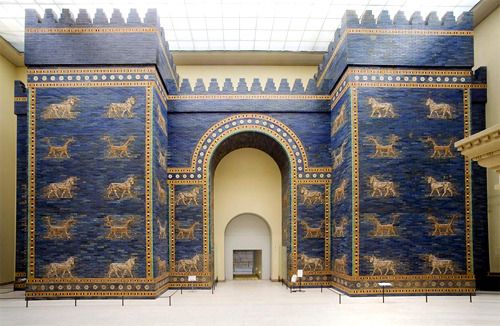
The lion with eagle’s wings was the national emblem of Babylon. The photo is a reproduction of what the ancient gate of Babylon, known as the Ishtar Gate, might have looked like. And on or near the gates of Babylon, there were statues or reliefs of winged lions guarding the gates.
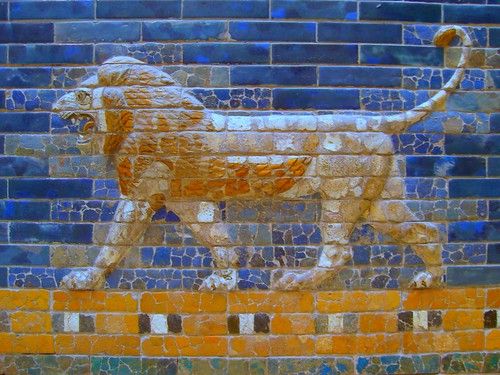
Its wings being plucked would indicate its loss of power as an empire, but yet it stood up as though it were transformed into a man, because it says a man’s heart or mind was given to it.
What that indicates—and it will become more clear later in these blogs—is that the head of gold, as the mind of carnal man, was not destroyed when Babylon fell, but that head became the controlling influence and the heart or vital force of all the succeeding empires.
In other words, although the king was slain and the city itself—the real estate and buildings were ultimately destroyed, yet Babylon as the head, the brains and heart, lives on secretly all down through the centuries in the succeeding empires—hence, in Revelation, John calls it “that great city, Mystery, Babylon the Great!”
I also call your attention to the phrase “that great city.” Only three cities were called that in the Bible. Nineveh, capital of the Assyrian Empire was called “that great city” three times. Mystery Babylon is referred to as “that great city” six times, and then at the very end of the book of Revelation, New Jerusalem is called “that great city,” once again showing how the kingdoms of this world become the kingdom of our Lord and of His Christ, which is the Stone Kingdom.
Meanwhile, the fact that Babylon, the head of gold, is still in control today is a mystery! Does that mean that no one in the world ever knew about it? Of course not. It is a secret. It is control hidden from the masses. But somebody had to hide it and keep it secret.
There have always been the very few, the elite of all ages, who sit as the head, and they have passed the secret to their heirs all down through the centuries. Those heirs could be either family heirs, philosophical heirs, or especially in the past two centuries, the heirs of commerce and corporations. Back to Daniel 7.
Daniel 7:5 And behold another beast, a second, like to a bear, and it raised up itself on one side, and it had three ribs in the mouth of it between the teeth of it: and they said thus unto it, Arise, devour much flesh.
Remember, this visionary dream came to Daniel in the first year of Belshazzar. The Medes and Persians were strong nations on the horizon, but they had not yet sought to topple Babylon. So Daniel himself did not yet know that the Medes and the Persians were called to overthrow Babylon. If we turn to the next chapter, however, that is where Daniel is informed of this fact.
Daniel 8:1 In the third year of the reign of king Belshazzar a vision appeared unto me, even unto me Daniel, after that which appeared unto me at the first.
I think that phrase “at the first” must refer back to what we just read in chapter 7, the vision of the four beasts.
Daniel 8:2 And I saw in a vision; and it came to pass, when I saw, that I was at Shushan in the palace, which is in the province of Elam; and I saw in a vision, and I was by the river of Ulai.
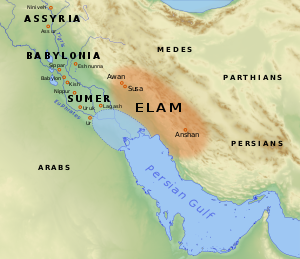
Notice that it does not say that Daniel himself was physically in the palace at Shushan, but in the vision, that is where he found himself. He was there in spirit just as Ezekiel said he was in Jerusalem in spirit when he was actually and physically with the captives of Judah in Babylon. That is in Ezekiel 8:3, if you want to look it up later. The city of Shushan was the capital of Persia. Daniel goes on.
3 Then I lifted up mine eyes, and saw, and, behold, there stood before the river a ram which had two horns: and the two horns were high; but one was higher than the other, and the higher came up last.
Modern Iran is the land of ancient Persia and the city-state of ancient Babylon is in modern Iraq. The Euphrates River flowed through downtown Babylon, but the river referred to in the vision is not the Euphrates, but the river Ulai which was near the palace in the capital (Shushan, aka Susa) of the rising Persian empire.
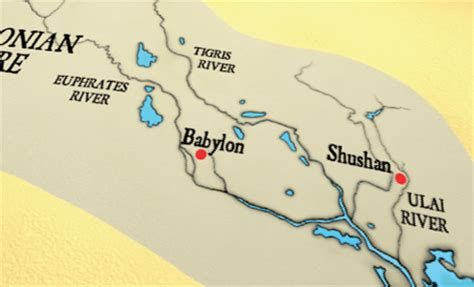
Now Daniel says:
4 I saw the ram pushing westward, and northward, and southward; so that no beasts might stand before him, neither was there any that could deliver out of his hand; but he did according to his will, and became great.
Once again Daniel is perplexed and disturbed by the vision and once again, divine assistance is rendered as an angel explains:
Daniel 8:20 The ram which thou sawest having two horns are the kings of Media and Persia.
Alright, so Daniel now knew that Babylon was going to be overthrown by the Medes and the Persians. Because we saw in verse 4 that the ram (Persia) did not push eastward, but westward. And what was directly west of Persia/Iran? It was Babylon/Iraq. As further identification, we know that the ram was the national emblem of Persia, just as the winged lion was of Babylon.
But then what about the dream-vision of Daniel in chapter 7, verse 5, where this second beast is described as a bear? Which is it? A bear or a ram? Well, obviously, it is both. The three passages in the book of Daniel that we are examining, are all describing different aspects or characteristics of the same four empires.
The bear is associated with Medo-Persia because it denotes the fierce and barbarously cruel character of its armies. If you thought the Babylonian armies were bad, they looked like a prayer group in comparison to the Medes and Persians.
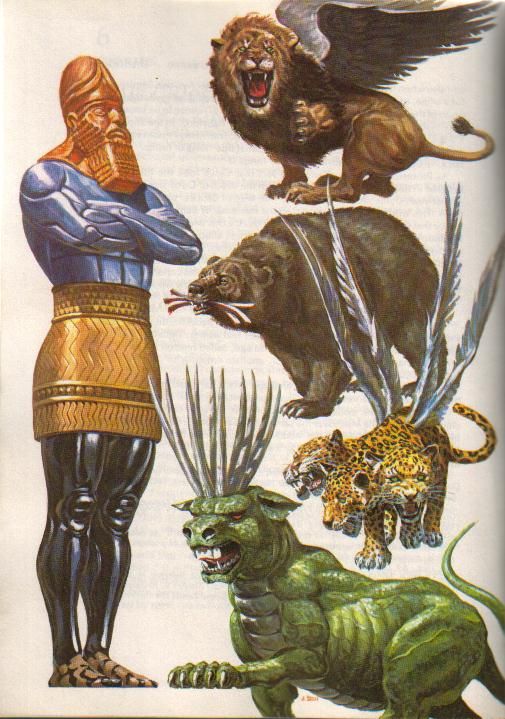
Daniel 7:6 After this I beheld, and lo another, like a leopard, which had upon the back of it four wings of a fowl; the beast had also four heads; and dominion was given to it.
Once again, we turn to chapter 8, and let’s see how Daniel’s vision of two years later describes the brass or leopard empire.
Daniel 8:5 And as I was considering, behold, an he goat came from the west on the face of the whole earth, and touched not the ground: and the goat had a notable horn between his eyes.
6 And he came to the ram that had two horns, which I had seen standing before the river, and ran unto him in the fury of his power.
7 And I saw him come close unto the ram, and he was moved with choler against him, and smote the ram, and brake his two horns: and there was no power in the ram to stand before him, but he cast him down to the ground, and stamped upon him: and there was none that could deliver the ram out of his hand.
8 Therefore the he goat waxed very great: and when he was strong, the great horn was broken; and for it came up four notable ones toward the four winds of heaven.
Then we drop down to verse 21 because here the angel also identifies this third kingdom.
Daniel 8:21 And the rough goat is the king of Grecia: and the great horn that is between his eyes is the first king.
This would be long after Daniel had passed away, but what Daniel did know before he died, was that the Medo-Persian Empire would in due course succumb to and be succeeded by a Greek Empire.
We know from history just how precisely accurate this prophecy was, and of course, we know that the he-goat or the rough goat was Alexander the Great. And like a leopard with wings, his armies moved so swiftly in their conquests that I think it was only a matter of six years and he had conquered and put together a huge empire all the way from Greece to Egypt, Arabia and Ethiopia, through Syrian and Babylon, and as far east as into India.
Whereupon Alexander went to live in Babylon, and then suddenly, he died at the age of 33! Incidentally, just as the winged lion was the emblem of ancient Babylon, and the ram was the national emblem of Persia, so also was the goat a symbol of ancient Greece. If you look at verse 8 once more, it prophesies that the horn, which represents Alexander himself, was broken, and in his place came up four notable ones.
This was fulfilled as four of Alexander’s top generals decided to split the Greek Empire into four parts, each ruling their own quadrant, as it were.
At this point, we shall conclude for now because this is a good stopping point. We have discussed the first three empires, and just as a quick review, here is how they correlate:
Babylon, the head of gold, and the winged lion. Notice how there is no correlation to ancient Babylon in chapter 8, probably because that was the third year of Belshazzar and that empire was approaching its demise. So then we have
The breast and arms of silver in Nebuchadnezzar’s dream correlates to the ferocious bear of Daniel 7, and it also correlates with the ram of chapter 8. That is the Medo-Persian Empire. The two horns symbolize Darius the Mede and Cyrus the Persian, with Cyrus being the taller horn, because he became more powerful than Darius. Then that was followed by
The belly and thighs of brass in Nebuchadnezzar’s dream correspond to the winged leopard of Daniel 7, and the he-goat or rough goat of Daniel 8. That is the Greek Empire, initially under Alexander the Great.
Obviously, there is much more that I have omitted today from our discussion in identifying these empires, but this is a good stopping point because it is true that there is almost unanimous agreement among Bible scholars as to these identities.
Well, I should qualify that to say there is almost unanimous agreement among the Bible scholars who actually believe in the inspiration of the Bible. So that excludes the Higher Critics, which would encompass many ministers and theologians in the mainstream denominations today and, of course, the church of Rome.
When we continue next time, and as we get into the fourth kingdom of Daniel 2, and beyond to the Stone Kingdom, that is where it really begins to get interesting because there is much disagreement in interpretation. Some say this, and some say that, and—well, you’ll see, so I hope you continue to study these teachings on Mystery Babylon and the Stone Kingdom.
 Chapter 7 - Daniel Unsealed The Fourth Beast Kingdom, Part 1
Chapter 7 - Daniel Unsealed The Fourth Beast Kingdom, Part 1